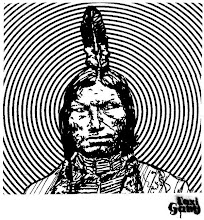Hi Alex,
That book on Graffiti that requested a few of my photos has
come out and yours is included.
I have to start with a few apologies since they actually
did not credit your work and I told them all the details.
Likewise the text that goes with all of the images is...
Well, not very good, like the book that is a bit
pretentious and simplistic. It is still a good selection of
street art but not the one it pretends to be and certainly
narrow in the selection. For instance my photos are the
only ones representing DC, which I find really limiting.
Anyhow, this is the pict that you will find there:

And the book is here:
Street Art and the War on Terror: The Images of Opposition: How the World's Best Graffiti Artists Said No to the Iraq War

I've also thrown a brief review (in Spanish) and may do an
English translation: http://daquellamanera.org/?q=node/337
Cheers,
Daquella manera
http://www.daquellamanera.org
Following is a poorly translated [babelfish] version of the above mentioned review:
"street Art and the war against the terror" is I title of a book that compiles global samples of street art during the administration Bush in the United States and critics with its policies. After the subtitle "as the best artists of the graffiti said not to the war in Iraq" it offers so much an interesting sample as some lagoons in his exposition.
In the book I am involved like author with the four images that I have donated of Washington DC. And while I feel been thankful whenever I have the opportunity to diversify the representations of this city and to offer something of its more complex and distant reading, also is certain that those are many that as much look for perspective common in their documentation of the city like in their artistic interventions. In fact it is a flattering but uncomfortable surprise that DC has been only represented through my photos.
Many cases of grouping to all the samples under a direct protest against the call "war against the terror" and the war and occupation of Iraq one becomes a heavy exercise of generalization. An exercise that hides obvious shades and not so obvious, as ramillete of protests that more are related to anticapitalist feelings, aspects of the American culture, or critics to the contemporary idiosyncrasy, that related explicitly to the effective American government. In the same way, the texts seem not to be writings in relation to the authors of works, nor in relation to the authors of the action as those of the photography in if. This generates therefore a text generic, often gratuitous that responds to the personal reflection of Xavier Tápies, publisher to the position of that aspect. They are commentaries that they often look for to illustrate images that do not need it and worse still many are the conclusions on the represented thing that they do not correspond with the local context. It is thus largely in the images of Washington and in that sense it would add to double value the idea of offering the image without other people's narrative instead of generating a filling forced.
The complica problem when it seems that the name of the photographer with the one of the artist is mixed in the credits who exerted the action, thing that in cases can represent the same person but who frequently it is not it. In the same way there are many anonymous works that with the suitable time and dedication could have been assigned to artists and local movements. It happens for example with this image that has been created by Gang Taxi, and thus I let it know to the publishers although the work appears finally like anonymous.
Perhaps these are publishing problems, but they comprise of a proud publishing strategy and until sensationalist who nonaid to which it would have to be the essential intention of the book: to approach the street artistic representations that look for a social trasformación, trasformación in the context of the answer to the recent global policy. But it is that arrogance the one that allows to read that we are before "the best artists" or like the publisher is been present "in all the significant magazines underground of London and Berlin" to the point of which it seemed that the one is he that legitimizes the magazine if it appears in them and the others did not have importance. In the same way that in the perhaps smaller aspect of the technique we are not solely before graffitti but before a quite diverse number of ways to make art in the public surroundings.
It is an unfortunate subject because the book in last instance is recommendable to give a look to an interesting selection of images, that although do not adjust to which the book tries to present/display, if it offers a sample of the energy and variety of voices of a political and dissonant art. An art that remembers in paper archives, and is more alive in digital surroundings but that there are to look for and to do in the street.





